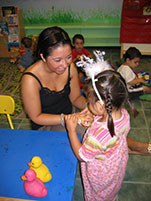PAL Separation Guidelines
 Our experience at PAL is that GRADUAL SEPARATION tends to work best for young children. However, the teachers evaluate each individual child’s separation technique based on the child’s reaction towards it. To prevent children from becoming overwhelmed, the amount of time an adult is in the classroom is ideally limited, but evaluated on a case-by-case basis to ultimately do what is best for the child’s adjustment and development.
Our experience at PAL is that GRADUAL SEPARATION tends to work best for young children. However, the teachers evaluate each individual child’s separation technique based on the child’s reaction towards it. To prevent children from becoming overwhelmed, the amount of time an adult is in the classroom is ideally limited, but evaluated on a case-by-case basis to ultimately do what is best for the child’s adjustment and development.
Our TYPICAL SEPARATION GUIDELINES are as follows:
1. For the first session or two of PAL, a parent or caregiver can accompany the child and remain in the classroom for the duration of the session.
2. After the first session or two, the parent or caregiver can gradually leave the classroom.
3. For the first two sessions that the child is in the classroom on his or her own, the parent or caregiver should remain in the lobby for the duration of the session. The child can then go check in with their parent or caregiver in the lobby as needed.
4. After two such classes, however, the child will be helped to remain in the classroom for the duration of the session, without going to the lobby to check in with the parent or caregiver.
Of course, these guidelines can and should be customized to meet the needs of individual children.
Some children are ready for separation much earlier than others. For those who are younger or simply have more difficulty with separation, this process can be stretched out over a longer period of time.
CONSISTENCY is key. Once the parent has decided that the child is ready for complete separation, the parent or caregiver should remain outside the classroom and make every attempt not to return to the class, even if the child begins to cry. The teacher and teacher’s assistant will help to make the child feel more comfortable in this situation.
PRACTICE and PREPARE with your child. Parents and caregivers, along with the teacher, should keep the child informed of what is going on during the separation process. Before PAL starts, the parent or caregiver can let the child know that he or she will be accompanying the child to the first session or two and then will be waiting outside in the lobby. This should be emphasized several times.
In addition, on the day on which the complete separation will take place, the parent or caregiver should let the child know that the child will stay in the classroom by him or herself for the duration of the session and that the parent or caregiver will be waiting for them at the end of the session.
In the classroom, point out specific positive features of the room, such as special toys that the child may like or may also have at home, or special activities that the child enjoys.
Rehearse separation through play activities at home. You and your child can use figures, dolls, or stuffed animals to enact skits of a child going to school, a parent leaving, and the children and teachers having fun together in the classroom.
STAY POSITIVE! Children are experts at being in tune with their parents’ and caregivers’ moods. If the parent and caregiver smile while talking about school and seem calm about the separation process, the child is more likely to feel positive and calm as well.
